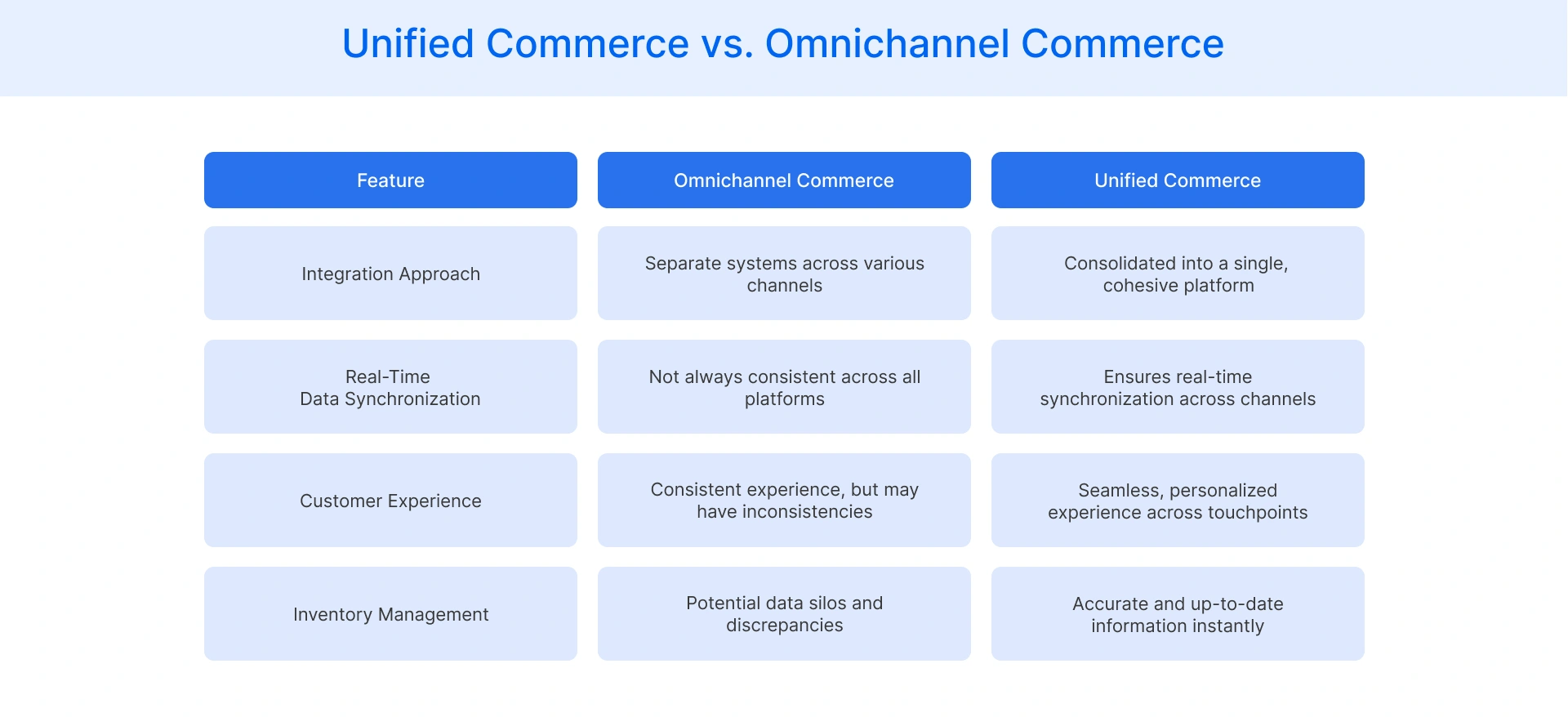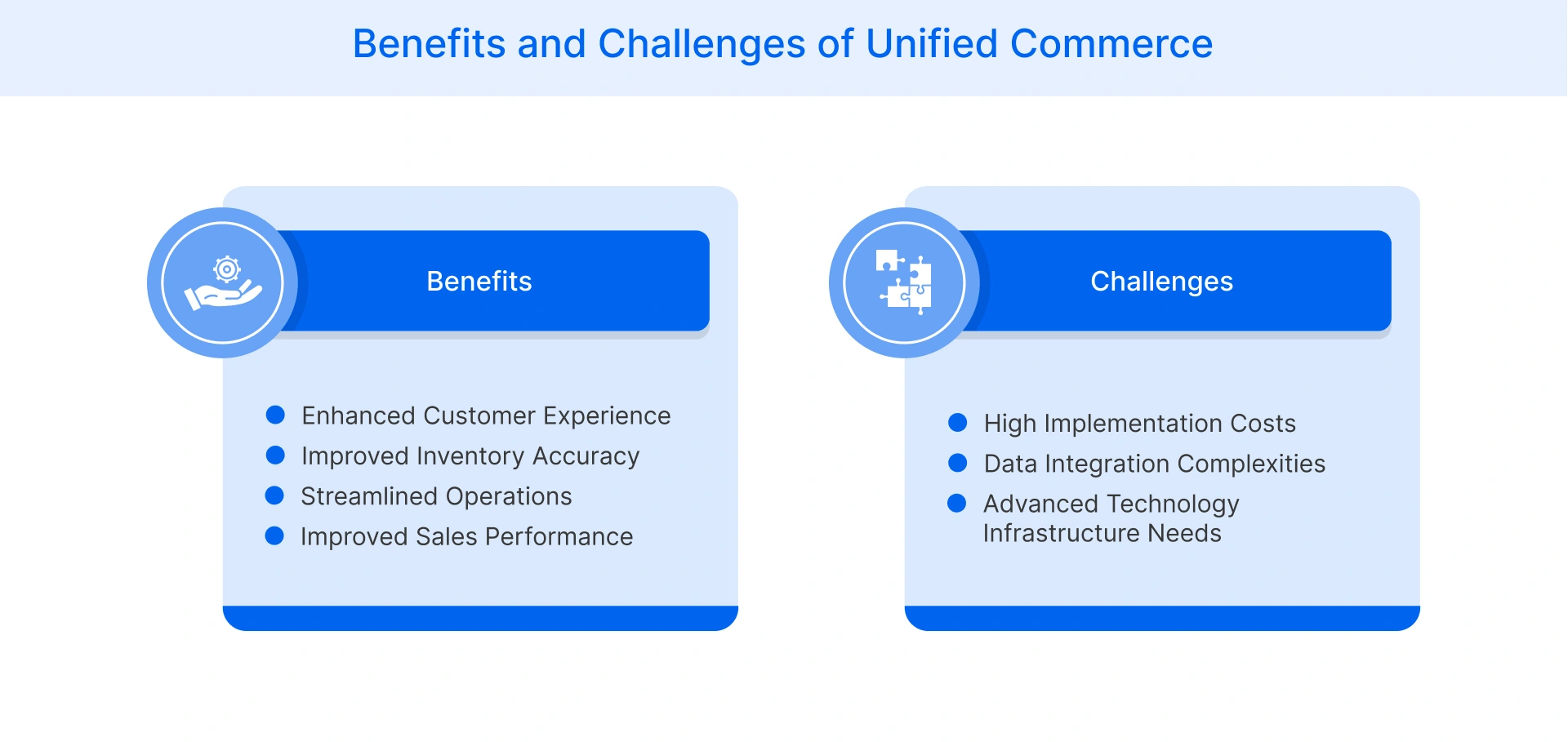Table of Contents
- What is Unified Commerce?
- Key Components of Unified Commerce
- Unified Commerce vs. Omnichannel Commerce
- How Unified Commerce Works?
- Key Benefits of Unified Commerce
- Challenges of Implementing Unified Commerce
- Best Practices for Implementing Unified Commerce
- Conclusion
What is Unified Commerce?
Unified commerce is a strategy that integrates all sales channels, inventory management, customer data, and payment systems into a single, connected platform. This approach ensures a seamless and consistent experience across all customer touchpoints, whether online, in-store, or via mobile applications.
By centralizing these components, businesses can provide real-time information, streamline operations, and enhance customer satisfaction. This integration allows for better data visibility and operational efficiency, enabling retailers to respond swiftly to market changes and customer needs.
By breaking down silos between different sales channels and backend systems, a unified approach empowers retailers to respond more quickly to market changes and customer preferences. It also facilitates a more agile approach to business decisions, enabling businesses to adapt and scale their offerings with greater ease.
Key Components of Unified Commerce
Here are the primary components of unified commerce:
Integrated Sales Channels
Unified commerce connects all sales avenues, such as e-commerce sites, physical stores, mobile applications, and social media platforms, into a single, seamless system. This integration ensures customers experience consistent service, regardless of the channel they choose. For instance, a shopper might browse products online, purchase them through a mobile app, and pick them up in-store, all while enjoying a unified commerce approach.
Centralized Customer Data Platform (CDP)
A unified commerce strategy relies on a centralized customer data platform that gathers and analyzes information from all channels. This comprehensive view allows businesses to personalize interactions and tailor marketing efforts effectively. By understanding customer preferences and behaviors, retailers can offer personalized recommendations and promotions, enhancing engagement and loyalty.
Unified Payment Processing
Integrating various payment methods, such as digital wallets, credit/debit cards, and in-store payment systems, into a single platform simplifies transactions for both customers and retailers. This unified payment processing ensures a smooth and secure checkout experience across all channels, reducing friction and enhancing customer satisfaction.
Advanced Inventory and Order Management
A centralized system for inventory and order management provides real-time visibility into stock levels across all channels. This transparency enables efficient order fulfillment, reduces the risk of stockouts or overstocking, and allows customers to access accurate product availability information, regardless of the shopping platform they use.
AI-Driven Personalization and Analytics
Incorporating artificial intelligence and machine learning into a unified commerce framework allows retailers to analyze customer data deeply and deliver personalized experiences. AI-driven tools can recommend products, predict trends, and optimize pricing strategies, thereby providing a seamless shopping experience and boosting operational efficiency.
Unified Commerce vs. Omnichannel Commerce
While both unified commerce and omnichannel commerce aim to enhance customer experiences across multiple channels, they differ fundamentally in their integration approaches.
The omnichannel approach focuses on providing better customer service across various channels, such as online stores, physical retail locations, and mobile apps. However, these channels often operate on separate systems, leading to potential data silos and inconsistencies. For example, inventory information might not update in real-time across all platforms, causing discrepancies between what's shown online and what's available in-store.
In contrast, unified commerce consolidates all channels and backend systems into a single, cohesive platform. This integration ensures real-time data synchronization, providing accurate and up-to-date information across all touchpoints. As a result, customers enjoy a seamless experience, whether they are shopping online, via a mobile app, or in a brick-and-mortar store. For instance, a unified system allows a customer to check product availability online and reserve it for in-store pickup, with the inventory reflecting this action immediately.

How Unified Commerce Works?
Here are the core components that drive unified commerce:
Centralized Data Management
Unified commerce relies on a single data repository for customer interactions, transactions, and inventory. The centralized data management system improves operational efficiency by providing real-time insights into customer behavior and inventory levels. This holistic approach allows retailers to make informed decisions, streamline processes, and enhance overall productivity.
Seamless Customer Experience Across Channels
A unified commerce strategy ensures customers can switch between online, mobile, and in-store experiences without disruptions. This seamless integration across channels provides a consistent and cohesive shopping journey, enhancing customer satisfaction and loyalty. Retailers can deliver a unified brand experience whether customers shop online, use a mobile app, or visit a physical store.
Real-Time Synchronization of Sales and Inventory
Real-time synchronization of sales and inventory is crucial for preventing stockouts and overstocking. By maintaining accurate and up-to-date inventory records, retailers can optimize stock levels and ensure products are available when and where customers need them. Automated order updates and real-time stock visibility enable efficient inventory management and deliver a consistent customer experience.
Key Benefits of Unified Commerce
Implementing a unified commerce strategy offers several advantages for your retail business:
- Enhanced Customer Experience: By integrating different channels into a unified platform, you provide customers with a seamless and consistent shopping journey, whether they are purchasing online, in-store, or via mobile apps.
- Improved Inventory Accuracy: Centralizing inventory management allows for real-time stock visibility across all channels, reducing the risk of stockouts or overstocking. This ensures that customers have accurate product availability information.
- Streamlined Operations: A unified system consolidates various backend processes, such as order fulfillment, payment processing, and customer data management. This leads to increased operational efficiency and reduced administrative overhead.
- Improved Sales Performance: By providing a cohesive shopping experience and utilizing centralized data, you can better understand customer preferences, tailor marketing efforts, and drive higher conversion rates.

Challenges of Implementing Unified Commerce
While unified commerce offers numerous benefits, implementing it can present certain challenges:
- High Implementation Costs: Transitioning to a unified commerce platform may require significant investment in new technologies, system integrations, and staff training. This can be a substantial financial commitment for your business.
- Data Integration Complexities: Merging data from various channels and legacy systems into a single platform can be complex. This requires careful planning to ensure data consistency and accuracy.
- Advanced Technology Infrastructure Needs: Implementing a unified commerce strategy necessitates a robust and scalable technology infrastructure. It should be capable of handling real-time data processing and integration across multiple channels.
Best Practices for Implementing Unified Commerce
Here are the best practices to consider when embarking on your unified commerce journey:
- Choose scalable technology: Select a unified ecommerce platform that can grow with your business needs and adapt to changing market conditions. This ensures long-term viability and reduces the need for frequent system overhauls.
- Leverage AI-driven personalization: AI and machine learning can significantly enhance the customer experience by providing tailored recommendations and interactions. For example, the Flipkart Commerce Cloud (FCC) E-commerce Demand Engine utilizes advanced solutions to boost customer engagement across all touchpoints. This technology empowers you to deliver the personalized experiences that foster customer loyalty and drive sales.
- Prioritize data security: Implement robust security measures to protect sensitive customer information across all channels. This will build trust and ensure compliance with data protection regulations.
- Implement a centralized customer data platform: A unified view of customer data is crucial for delivering consistent and personalized experiences across all channels. FCC's comprehensive Digital Commerce Solution provides this unified view, enabling personalized marketing and improved customer service. This 360-degree view of your customers empowers you to make informed decisions and create highly targeted campaigns.
Conclusion
Unified commerce is essential for businesses aiming to provide an integrated and seamless customer journey. By unifying sales channels, inventory, and customer data, retailers can offer a consistent shopping experience, improve operational efficiency, and drive sales growth. Implementing unified commerce requires careful planning and investment, but the benefits far outweigh the challenges. With the right technology and best practices, businesses can achieve a truly integrated retail environment.
FAQ
Data serves as the cornerstone of unified commerce, facilitating the seamless integration of sales channels, inventory management, and customer interactions. Accurate, real-time data ensures consistent information across all platforms, enabling informed decision-making, personalized customer experiences, and efficient operational processes.
By consolidating customer data from various touchpoints into one centralized system, unified commerce enables businesses to gain a comprehensive understanding of individual preferences and behaviors. This holistic view allows for tailored marketing strategies and personalized shopping experiences, fostering increased customer engagement and loyalty.
Unified commerce enhances supply chain efficiency by integrating all sales channels and backend systems into a single platform. This integration provides real-time visibility into inventory levels, streamlines order fulfillment, and reduces operational redundancies, leading to a more responsive and agile supply chain.

